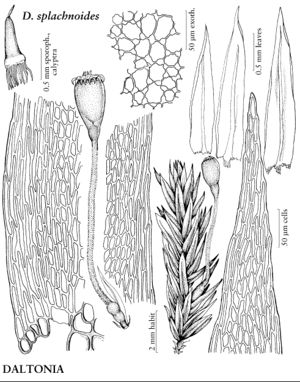Daltoniaceae
Plants small to medium-sized, turfs or mats, dark green, yellow-green, or brownish. Stems short, often deep red, terete-foliate [complanate], not or sparingly branched; transverse section cells moderately differentiated, cortex deeply red pigmented, outer cortical cells somewhat smaller, walls thicker, inner cortical cells somewhat larger, walls thinner, central strand usually absent; pseudoparaphyllia absent [rarely filamentous]; rhizoids from stem base, sometimes clustered below leaf base, sparingly branched (not 2- or 3-pinnate); axillary hair cells hyaline, 3–4(–12), basal cell usually small, brown. Leaves spirally inserted, crowded, isophyllous [often dorsiventrally differentiated and asymmetric]; margins plane or variably revolute on same stem (throughout one side, partially proximally or distally), entire, serrate, or ciliate, bordered [rarely not bordered]; costa usually single, stout; alar cells not differentiated; laminal cells short, usually rounded, isodiametric [oval], rhomboidal, hexagonal, or elongate-hexagonal, smooth, walls usually firm or incrassate. Specialized asexual reproduction various, infrequent to common. Sexual condition autoicous [dioicous], or synoicous. Seta lateral, usually elongate, smooth or roughened to spinose. Capsule erect or inclined; annulus absent [present]; operculum erect, subulate, beaked; peristome diplolepidous, double; exostome teeth 16, thin, not bordered or furrowed [outer plates thick, furrowed, cross striolate], papillose [spiculose throughout]; endostome basal membrane low, segments densely papillose, cilia reduced or absent. Calyptra mitrate, base with [without] fringe of 1-celled [multicellular] hairs, 1-stratose at middle, usually naked, rarely densely hairy.
Distribution
Nearly worldwide, mainly tropical and hyperoceanic south temperate regions.
Discussion
Genera 14, species ca. 150 (1 in the flora).
Most genera of Daltoniaceae are complanate-foliate (W. Frey 2009+, part 3); it is conspicuous that Daltonia, the only genus in the flora area and one of the three largest in the family, has terete-foliate leaves that are spirally inserted. Daltonia is one of the few genera in the family to display a synoicous sexual condition, in addition to autoicous but not dioicous species. Only Distichophyllum Dozy & Molkenboer, usually dioicous or autoicous, is rarely synoicous (Frey). The leaf shape of Daltonia is also distinctive in the family. Leaves of many Daltonia species are lanceolate with nearly parallel margins and gradually acuminate apices, quite distinct from the ovate or obovate, abruptly apiculate or obtuse leaves common in other genera in the family. Daltonia shares the epiphytic characteristic of the family.
Selected References
None.
Lower Taxa
Illustrations
| Family ⠉ | Taxon | Illustrator ⠉ | |
|---|---|---|---|
 | Daltoniaceae | Daltonia splachnoides | Patricia M. Eckel |